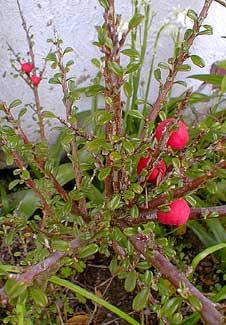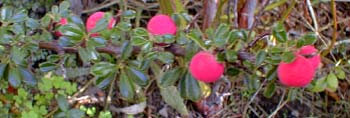
Little-leaf Cotoneaster; or,
Chinese Rockspray
"I come to pluck your berries harsh & crude."
-John Milton
(1608-1674)
(1608-1674)
Native of the Himalayas & cold-hardy to Zone 3, the Little-leaf Cotoneaster (Cotoneaster microphyllus) makes a fine low-maintenance small shrub in sun or partial shade.
It grows to two feet or thirty inches high. It is semi-evergreen, though with leaves so tiny that it does not have to lose many of them in winter to begin to look leafless. Specimens if selected for the limb shape will look beautiful year round.
Small white flowers in May become berry-like drupes that are a tad larger than for most cotoneasters & ripen swiftly. These have the appearance of a matt finish, which makes them a bit different than other cotoneasters' berries.
These rose-red pastels cling to the shrub for months, including through the whole of winter. The first photo above is from April, the second from November, which conveys the long-lasting presence & beauty of the fruits.
 The fruits are in theory edible, though fairly awful if attempted raw. Cooked, sieved, sweetened, & spiced, they make an acceptable substitute for cranberry-sauce, & can be mixed with other bitter autumn berries, such as hawthorn & rowan berries, or with actual cranberries. They can make adequate jellies if mixed with sweet apples, or for a cotoneaster-applebutter. They're best if harvested after they are "frosted off" but if plucked before a good frost, they can be artificially frosted off with just a couple days in the freezer.
The fruits are in theory edible, though fairly awful if attempted raw. Cooked, sieved, sweetened, & spiced, they make an acceptable substitute for cranberry-sauce, & can be mixed with other bitter autumn berries, such as hawthorn & rowan berries, or with actual cranberries. They can make adequate jellies if mixed with sweet apples, or for a cotoneaster-applebutter. They're best if harvested after they are "frosted off" but if plucked before a good frost, they can be artificially frosted off with just a couple days in the freezer.But the berries are also very nice to just leave where they're at for winter beauty in the garden. The combination of teency leaves & largish berries makes this shrub particularly charming & distinct among the smaller cotoneasters.
It is good in dry sun-gardens & rockeries, & makes a grand beginner's bonzai item. Ours grows at the foot of a yellow Lady Banks' Rose. This rose, in our climate, requires no watering except possibly a bit at the very height of summer, & the drought-hardy cotoneaster makes a perfect companion.
Ours is a wild form with very upright branches. The majority of cultivars weep, arch, droop, or are rounded, but ours is exceedingly the upright vase form.